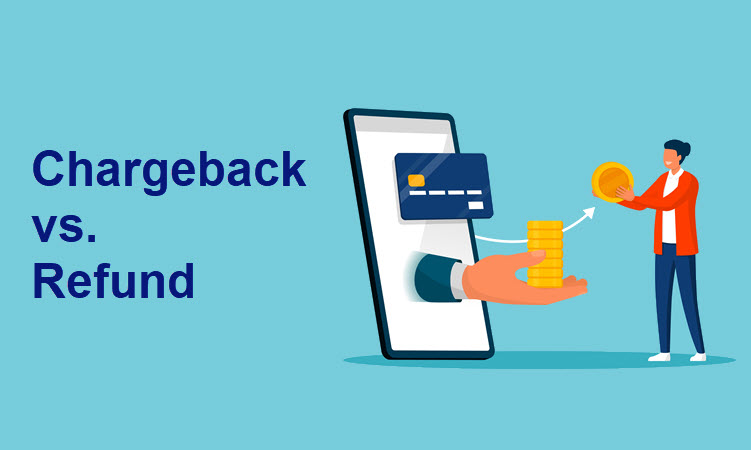When a buyer is not happy with the product they’ve purchased or the service they’ve received, they ask for a chargeback or a refund.
The funds are returned to the buyer’s account in both cases, but these two procedures differ significantly, especially for merchants.
This article outlines the differences between chargebacks and refunds, providing tips for handling them.
Chargeback vs. Refund: Definitions

Customers have two options at their disposal when filing a payment dispute: a chargeback and a refund. These terms are sometimes used interchangeably but involve different processes with different implications for merchants.
Chargebacks
A chargeback happens when a cardholder disputes a transaction made from their debit or credit card and demands that their issuing bank reverse it. Customers demand a chargeback for the following reasons:
- The goods or service is no good.
- The transaction is fraudulent and wasn’t authorized by the customer.
- Delivery issues.
- The price is different, and the customer was charged more.
- The customer forgot about a subscription renewal.
Once a chargeback request has been submitted, the card-issuing bank analyzes the request. The issuing bank works with the merchant’s acquiring bank to determine what happened and resolve the issue. The merchant’s acquiring bank asks the merchant to provide documentation related to the chargeback request.
If the merchant can prove that the cardholder authorized the transaction or that the goods were delivered on time and in good condition, the chargeback can be disputed.
The whole procedure is both time-consuming and distressing for the merchant because the issuing bank usually returns the money to the customer upon receiving a chargeback request. Even if the issuing bank concludes that the merchant is right at the end of the process, they need to wait for 60-90 days to get the money back.
Refunds
A refund happens when a merchant returns the funds to a customer. It means that the customer has contacted the merchant, and the merchant has agreed to return the funds. The customer may need to provide a receipt and return the disputed goods to get a refund, depending on the merchant’s refund policy.
Note: We recommend you also read our post about chargebacks vs disputes.
Chargeback vs. Refund: Differences

Both chargebacks and refunds require that the funds are paid back to the customer. The key differences between chargebacks and refunds are:
The Parties Involved
Chargebacks
There are three participants in a chargeback procedure: the customer, the merchant, and the customer’s card-issuing bank. To file a dispute, the customer contacts their card-issuing bank. The bank then works the dispute out with the merchant. There is no direct communication between the customer and the merchant.
Refunds
In the case of a refund, the customer notifies the merchant that they’re dissatisfied with the product and asks for a refund. The merchant then returns the funds to the customer if they find the request reasonable and in accordance with their refund policy. There’s no third party handling the issue besides the merchant and the customer.
Additional Fees
Chargebacks
Issuing banks and card associations charge merchants with additional fees for handling chargeback procedures. The chargeback fees range from $20 to $100.
Refunds
There are no additional fees for merchants when they issue refunds directly to customers.
Time to Start the Dispute

Chargebacks
The four major card associations in the US – Visa, American Express, Mastercard, and Discover – give their cardholders 120 days to file a chargeback dispute, starting from the transaction’s effective date.
Refunds
Merchants’ individual refund policies define time limits for refund requests.
Time to Process the Dispute
Chargebacks
Typically, the issuing bank returns the funds to the customer at once upon receiving a chargeback request. However, a chargeback procedure takes 60-90 days to resolve.
Refunds
Once the merchant accepts the customer’s refund request, they can immediately pay back the disputed amount to the customer.
Limits
Chargebacks
Credit card associations track the following chargeback metrics:
- The total number of chargebacks within one month.
- The chargeback rate.
The general rule is that merchants stay below 100 chargebacks per month and not exceed one chargeback per 100 transactions (1%) made to their account monthly.
The chargeback rate helps card associations and banks identify merchants receiving a higher number of chargebacks. The number of chargebacks filed against the merchant within one month is divided with the total number of transactions handled by that merchant.
Note: Merchants operating in industries that have high chargeback ratios may be considered high risk and may need to go through an in-depth underwriting process.
Refunds
Credit card associations don’t impose refund policies nor track the number of refunds. These are specified and managed by merchants. A well-defined refund policy helps avoid any ambiguities and customer dissatisfaction.
Merchant’s Reputation
Chargebacks
A high chargeback rate can negatively affect the merchant’s ability to process payments. Credit card associations and acquiring banks may require from such merchants that they open a high-risk merchant account, subject to stricter supervision and higher processing fees.
Note: High-risk merchant accounts are difficult to open. However, payment service providers such as CCBill can help high-risk businesses process online payments.
Refunds
Credit card associations do not track a business’s refund rate. While refunds are an inconvenience, it does not affect the merchant’s ability to process payments.
Fraud Cases

While chargebacks are powerful means of consumer protection against unauthorized transactions from their credit and debit cards, some customers use them to trick merchants.
One of the most common fraudulent chargeback schemes is friendly fraud. A friendly fraud happens when a cardholder makes an online purchase and then asks for a chargeback, claiming that they didn’t initiate the transaction. When the issuing bank reverses the transaction, the cardholder gets the money back, and they keep the purchased goods.
Here’s what you can do to prevent fraudulent chargebacks and refunds:
- Require that buyers log in at checkout. It will ensure easier tracking of buyers and their payments.
- Ask buyers to provide additional details at checkout, such as the credit card CVV number or the CID number (the three-digit card verification values and the card identification number, respectively).
- Use an address verification system (AVS) to check whether the buyer’s billing address matches the buyer’s credit card account address to confirm their identity.
Secure payment processors provide modern payment authentication methods to help merchants avoid unwanted chargebacks. Having a secure online payment form is crucial in payment processing.
How to Prevent Non-Fraudulent Chargebacks and Refunds?
A chargeback damages the merchant’s reputation, no matter if it is honest or fraudulent.
Even though refunds don’t harm the merchant’s credit score, too many refund requests generally affect the merchant’s revenue stream. They take too much time and too many assets, which increases overall operational costs.
Here’s what you can do to prevent non-fraudulent chargebacks and refunds:
- Ensure 24/7 customer support and train your staff to handle refund requests quickly and effectively to prevent chargebacks.
- Offer top-notch products and services. High-quality goods reduce the number of refund and chargeback requests.
- Work with a reliable delivery service to ensure timely, damage-free deliveries.
- Work with a reliable payment processor.
- Tell the customers what they can expect to see in their bank statement for the purchase they’ve made.
Note: Refer to our post How To Choose a Payment Processor to learn how to find the right one.
What to Do When a Chargeback and Refund Happen at the Same Time?

Merchants can be charged both a refund and a chargeback at the same time. This happens when a customer simultaneously requires a refund from a merchant and asks the card-issuing bank for a chargeback.
If the merchant approves the refund and the bank reverses the transaction, the merchant is debited twice for the same thing. They also need to pay the chargeback fees. The customer receives twice as much as they’ve paid.
The double refund chargeback usually occurs when a merchant makes a refund without knowing that the chargeback process has started.
Some customers intentionally take advantage of this and commit friendly fraud, as explained above. Others have just lost their patience waiting for merchants to resolve their refund requests and demand a chargeback.
To avoid the double refund chargeback, make sure to ask the customer requesting a refund whether they’ve already filed a chargeback request. Provide the refund notice to the issuing bank if you’ve refunded the customer before they’ve filed a chargeback.
Note: Learn everything you need to know about statement descriptors i.e. text and numbers used to describe a transaction on a bank statement.
Conclusion
Chargebacks and refunds are legitimate options that buyers can use to protect their consumer rights.
On the other hand, merchants need to ensure that these protection tools aren’t used to harm their financial interests and credit score.
The explanations and tips provided in this guide will help both merchants and consumers understand and adequately use chargebacks and refunds.
